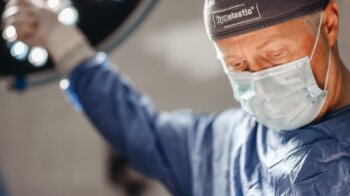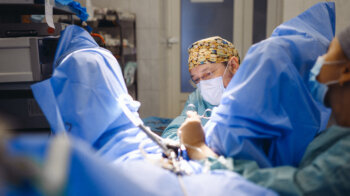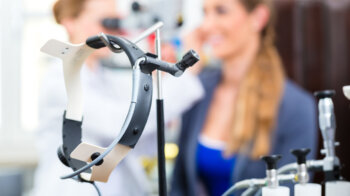A face lift is an operation (or several) in plastic surgery, the purpose of which is the correction of age changes and rejuvenation. It can be both a minimally invasive endoscopic intervention and a more traditional plastic surgery.
Lifting is a general name for all plastic surgeries on the face. Over time and gravity, facial tissue sags, so it’s the doctor’s job to fix it. Our plastic surgeons, in particular the head of the surgical department of the VIRTUS Institute Serhii Kadochnikov, recommend doing a facelift when noticeable skin sagging and deep wrinkles appear.
What are the types and methods of face lifting
The face consists of several anatomical areas: the temples (which includes the forehead), the middle and lower parts of the face, as well as the neck, which we also work with. Accordingly, face-lifting of the upper, middle, and lower parts of the face and neck can be distinguished. In practice, we most often perform the following types of face lifts:
- lifting of the face oval (circular lift);
- lifting of the lower triangle of the face (middle and lower parts) and neck;
- temporal lifting;
- forehead lift;
- eyebrow lift
In the transition period, when age changes do not yet require significant surgical intervention (patient under the age of 38-42), we perform partial endoscopic lifts, for example, temple lifting, cheek lifts or endoscopic lifting of the middle zone.
Endoscopic face lift
Endoscopic facelift is a minimally invasive method, during which the surgeon makes a series of small incisions (1.5-2.5 cm) on the scalp (temple, forehead) or inside the oral cavity, through which excess skin and fat are removed using an endoscope. fabrics This technique ensures quick healing, after 3-4 months these scars will be difficult to find even for the plastic surgeon who performed the operation. Other advantages are a minimal risk of complications and a shorter rehabilitation period. Endoscopic face lift is suitable for those patients who have less pronounced age-related changes, and the skin retains its tone.
Circular face lift
A circular face lift is an option for those who have more pronounced age changes, and therefore it becomes necessary to combine endoscopic surgery and lifting of the lower parts of the face with suturing of the muscular and aponeurotic systems. That is, it is a simultaneous operation that can include lifting of the neck, face oval, upper part of the face, plastic eyelids, lipofilling and other manipulations that rejuvenate all areas of the face, with one recovery period, which gives a long-lasting effect and the patient does not have to return to the question facial rejuvenation in the next 8-10 years. And even after this term, a woman who has had a facelift will look much younger than her peers. You can make sure of this by reading reviews of circular face lift from our patients.
What is SMAS-lifting
SMAS (superficial muscular aponeurotic system) is an abbreviation for the name of the anatomical structure, muscles and fascia that are found on the face. When a plastic surgeon performs an operation, he necessarily operates on the SMAS, because this is how it is possible to achieve a better and longer-lasting result of rejuvenation.
Currently, this term has become so widespread that cosmetologists have also started using it. After all, some high-energy devices (for example, radio waves) also act on the SMAS: they shorten the proteins of these structures due to the action of thermal energy, and in this way the face is tightened without surgery. Indeed, for some time it is possible to achieve a good effect without surgical intervention, only due to cosmetic procedures and exercises, but there comes a point when age-related changes cross a certain limit and they cease to be effective. Therefore, when we at the VIRTUS Institute decide how to help a patient, we always gather a council with the participation of cosmetologists and discuss whether it is better to send her to surgery or whether ultrasound lifting or stimulation with autogenous drugs is enough.
True SMAS rejuvenation is still a surgical operation that tightens the muscles and fascia of the face and provides the most stable and long-lasting result. But, as with any serious intervention, complications are possible after SMAS lifting: damage to peripheral nerve endings, which will affect the sensitivity of the face and facial expressions, infection of the wound area, formation of bruises and hematomas. This situation is not normal and requires additional treatment.
Temporal face lift
Temporal lifting (temporoplasty) is a lateral diagonal facelift in the temporal area, which is usually performed endoscopically. This operation allows you to get rid of shallow wrinkles on the forehead and around the eyes, raise the tips of the eyebrows, make the cheekbones more expressive, get rid of folds in the area of the nasolabial triangle and raise the folds above the upper eyelids.
By lifting the forehead, we also lift the eyebrows, but there are some types of operations that allow us to correct individual parts of the eyebrows: lifting the outer edges of the eyebrows, which allows us to give the eyes a more open expression, or lifting the eyebrows along the entire length. These are different processes, but only a quality result is important for the patient. Temporal face lift can be combined with blepharoplasty (surgery to change the shape of the eyelids to correct the incision of the eyes).
Lifting of the lower third of the face and neck
Rejuvenation of the lower part of the face and neck makes it possible to eliminate ptosis (sagging) of the cheeks, correct the line of the lower jaw, remove the second chin and improve the proportions of the neck-chin angle, visually rejuvenating the face. Such an operation can be indicated for younger people who do not have pronounced age changes, but have gained excess skin and fat in the area of the chin and cheeks after losing a large amount of excess weight.
If necessary, the lifting of the lower third of the face is supplemented by liposuction or, conversely, by the installation of chin implants.
How facelift operations are performed
Since it is a surgical intervention, before face plastic surgery, you should undergo research, do standard tests (clinical blood test, urine test, coagulogram) and visit an anesthesiologist’s consultation.
Facelift operations are performed in the operating room under general or local anesthesia, depending on the type of intervention being performed. Most often, it is sedation combined with local anesthesia – in this way, the surgeon has enough time to perform all the manipulations (a complex intervention, such as a circular face lift, can last 3-5 hours), and the patient does not remember the operation and is not afraid.
The postoperative period after a facelift does not require a long hospitalization – a patient who underwent rejuvenation of the lower third of the face and neck stays in the hospital for no more than 48 hours, and then only comes for dressings. There are no acute pain sensations.
Омолодження обличчя. Поєднана операція: пластичний хірург та косметолог
Indications for facelift surgery
Each of the areas of the face has its own signs that indicate the need for plastic surgery. Mostly, we are talking about the presence of visible age changes. Indications for a facelift are:
- violation of the contours of the lower jaw;
- ptosis of cheeks and chin;
- impoverishment of soft tissues of the middle zone of the face;
- pronounced dynamic forehead wrinkles;
- lowering of the eyebrow line and drooping of the upper eyelids;
- excess fat deposits in the neck and chin area;
- nasolabial folds, wrinkles in the corners of the eyes;
- lowering of the lower third of the face, the appearance of a second chin and the appearance of the platysma (the neck muscle that smoothes the angle of the chin).
“First of all, you should look in the mirror and ask yourself what exactly you don’t like,” says the leading plastic surgeon of the VIRTUS Institute Serhii Kadochnikov. — With the answer to this question, you can already turn to a plastic surgeon, who will tell you what exactly needs to be done. Because there are many methods, and the task is to choose the best and most balanced approach that will give the maximum result with a minimum of traces and a short postoperative period. So it also happens that it is better to tighten not those parts of the face that the patient complains about, but slightly different ones. Facial surgery is not an easy matter, sometimes it happens that I have to refuse the patient and offer her the best alternative treatment option.”
Contraindications to facelift
For the most part, obstacles to facelift are general surgical contraindications: recent stroke or heart attack, blood coagulation disorders, infectious diseases, serious general health condition, etc. As for the more specific contraindications for a face lift, these are:
- chronic diseases in the acute stage;
- inflammation of the skin;
- allergic reactions;
- recent injection of botulinum toxin, fillers, and other procedures that affect the skin and subcutaneous tissue.
Before a facelift, the patient’s state of health should be carefully examined in order to avoid possible complications.
How long does the result last after a facelift in different areas?
Usually, facelift surgery provides a high-quality, long-lasting result — for 8-12 years, the patient may not think about facial rejuvenation. But the result will be even better if you eat right, have enough sleep and physical activity and lead a healthy lifestyle.
Rehabilitation after a face lift
Patients usually tolerate facelift operations well and do not experience severe pain during the rehabilitation period. In general, recovery lasts 2-3 weeks, of which the first 4-6 days we work on reducing postoperative swelling. For this purpose, we prescribe physioprocedures. After the main edema subsides (7-10 days after the operation), it remains only to ensure that the small hematomas that remained in the area of surgical manipulations dissolve.
For 7 days after the facelift surgery, the patient must wear a compression bandage to prevent sutures from shifting. A maximum of 21 days after a face lift, you can return to the normal rhythm of life and enjoy prolonged youth.
Do you need to lift different areas of the face repeatedly?
Most of our patients return after 8-10 years. Depending on where the problems appeared during this time, we perform repeated or new surgery for lifting the upper or lower parts of the face, neck, plastic eyelids, and others. In the hands of a qualified surgeon, you should not be afraid of complications – the face will look beautiful both after the second and after the third operation.






 4516
4516  7 min.
7 min.














